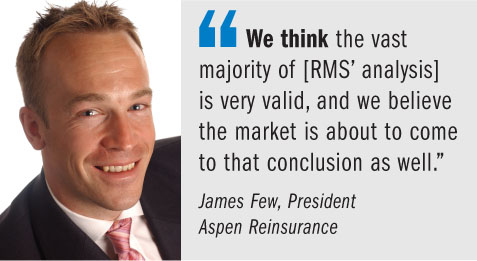Those who were anticipating rates to harden due to substantialupdates to Risk Management Solutions' (RMS) U.S. hurricane modelsay the impact has—so far—turned out to be less than expected.
| RMS Version 11.0 “wasn't thedriving factor that many people thought it would be when it came torenewals in January 2012,” says Insurance Information InstitutePresident Robert Hartwig.
RMS Version 11.0 “wasn't thedriving factor that many people thought it would be when it came torenewals in January 2012,” says Insurance Information InstitutePresident Robert Hartwig.
The updates to the cat model, which were based on analysis ofbillions of dollars in claims and reams of other data, increasedwind-related loss estimates for noncoastal areas and even inlandstates.
|It was widely assumed that as those changes filtered throughrisk portfolios, the impact on reinsurance rates for propertyexposures would be significant, especially for those with riskconcentrations in Texas and the Gulf States.
|So far that has not been the case, says James Few, president ofAspen Reinsurance in Hamilton, Bermuda: “The impact at Jan. 1[renewals] was noted and was noticeable, but not dramatic.”
|Few tells NU that Aspen Re, which has a closerelationship with RMS, completed an analysis of Version 11.0 in2011—and that the reinsurer believes the new model's impact will bemore evident with April, June and July renewals.
|Why? “The changes of risk for U.S. wind are really quitesignificant—both in terms of frequency and severity,” Few notes,adding that RMS' analysis is “very thorough. We think the vastmajority of it is very valid, and we believe the market is about tocome to that conclusion as well.”
|Few says the market has taken longer than he expected to analyzeand determine just how much of Version 11.0 will be accepted intheir business strategies.
|But since January, he adds, “more primary insurance companiesand reinsurers are finally deciding that they do want to take onboard the new science that RMS is bringing to the table.”
|So the shift that was expected at the end of last year, Fewexplains, is just happening now: A number of companies arediscovering they need to buy more reinsurance, he adds, which hebelieves will accelerate with April, June and July renewals.
|So what took so long? Few believes it was because Version 11.0was such a “dramatic change in science” for many companies. “Achange of that magnitude, you can't just accept at face value.”
|Few adds: “An increase in the perception of risk makes itdifficult to stay within your tolerances without either buying morereinsurance—which is what we're seeing from primary carriers—orreducing your overall aggregate.”
|Aspen Re CEO Brian Boornazian said during a conference call inJanuary that rates at Jan. 1 renewals rose between 7.5 percent and15 percent for larger property insurers and excess andsurplus-lines writers in the U.S. More increases were seen oncontracts affected by losses.
|But Hartwig believes that Version 11.0 “was just one of manyfactors, including market conditions,” behind those increases. RMSVersion 11.0's influence on pricing has probably beenoverestimated, at least to date, he adds.
Want to continue reading?
Become a Free PropertyCasualty360 Digital Reader
Your access to unlimited PropertyCasualty360 content isn’t changing.
Once you are an ALM digital member, you’ll receive:
- All PropertyCasualty360.com news coverage, best practices, and in-depth analysis.
- Educational webcasts, resources from industry leaders, and informative newsletters.
- Other award-winning websites including BenefitsPRO.com and ThinkAdvisor.com.
Already have an account? Sign In
© 2024 ALM Global, LLC, All Rights Reserved. Request academic re-use from www.copyright.com. All other uses, submit a request to [email protected]. For more information visit Asset & Logo Licensing.








